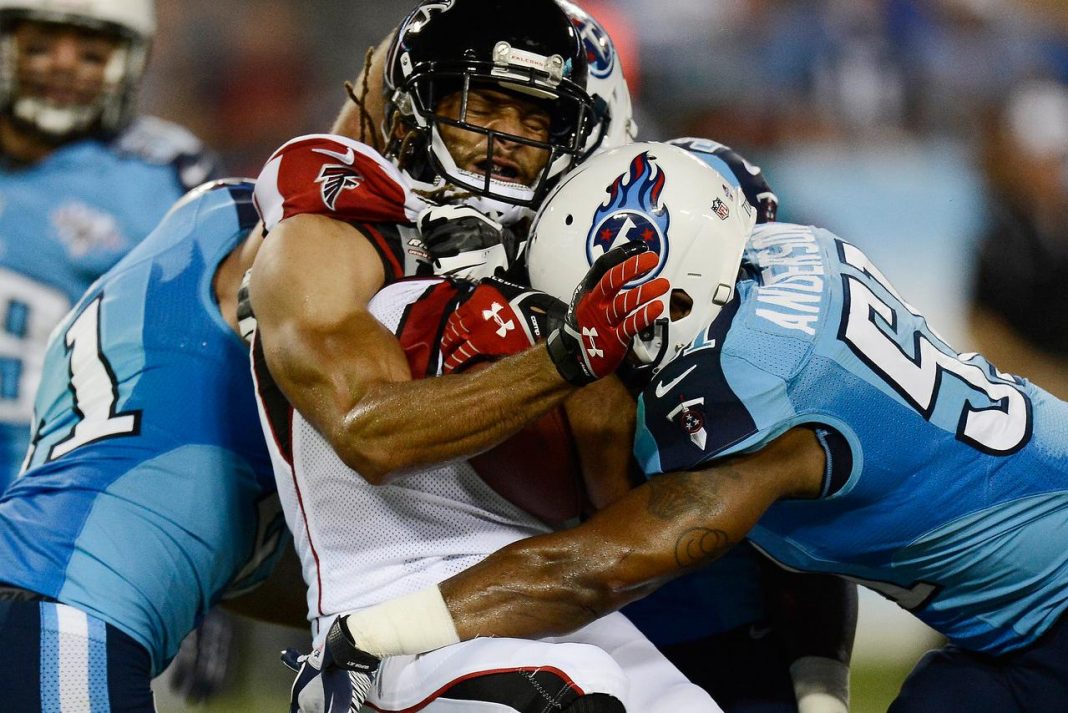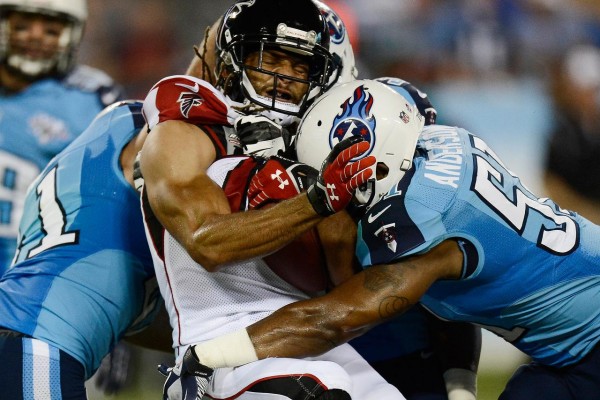
 Good to see Roger Goodell’s attempts to make the game safer are working.
Good to see Roger Goodell’s attempts to make the game safer are working.
As football fans know, the NFL has made quite a few rule changes over the past several seasons in an attempt to decrease the number of concussions and other serious injuries. Some people think that the changes are ruining the game, others support them completely.
I’m a bit more in the middle. Of course, I don’t want to see these players injured. No one does. But at the same time, I don’t think Goodell has helped anything. He’s just making players go low and tear ACLs, damage knees, and end players’ seasons.
But at least, concussions were on the decline…well, until this season.
There were 182 reported concussions during the 2015 NFL season—a 58 percent increase over the 115 from 2014. The number had been decreasing (173 in 2012, 148 in 2013) over the past few seasons, but 2015 has shattered that trend.
So what happened? Well, we aren’t exactly sure yet. Maybe it’s a complete failure of the rule adjustments, or maybe it was just a freak year.
Or, if you subscribe to Richard Ellenbogen, chairman of the NFL’s head, neck, and spine committee, the league has simply become better at identifying the injury.
“I see coaches report players and pull them out of the game,” said Ellenbogen, attempting to explain away the issue. “I see players report themselves. I see players report each other. Clearly, we’ve lowered the threshold for diagnosing a concussion, for pulling players out and evaluating them.”
Eh, that’s a stretch. A player checking into the protocol does not guarantee a concussion. So unless Ellenbogen is admitting that the league was not properly identifying concussions over the past few seasons, which means that the last few seasons’ numbers don’t really tell us anything, he hasn’t explained anything.
Either way, something needs to be done. With yet another young football player found dead and diagnosed with CTE, the problem is all too real. Until this problem is solved, the sport of football, in general, is in danger.
Concussions not NFL Players biggest concern though
What’s interesting is that concussions weren’t NFL players biggest concern, though. Here’s what the AP study brought out.
During a 15-year NFL career that sent him pinballing over the middle of the field too many times to count, absorbing hits as wicked as they come, former Denver Broncos receiver Brandon Stokley endured injuries that literally ran from head to toe.
And while, by his own estimate, that included, at least, a dozen concussions, the only health issue that made him seriously contemplate quitting the game was a problem with a small bone in the middle of his foot in his fourth season.
“I told my wife, ‘This is it. I’m done. I can’t deal with this pain every day,'” Stokley said in an interview with The Associated Press.
Yet he pressed on. Eventually, the foot pain subsided. The concussions? Those kept accumulating. Stokley, essentially, shrugged them off, despite the seemingly unending drumbeat of news about the dangers of head injuries. During his playing days, he was more worried about short-term effects than later-in-life ones.
“The thing with concussions is, usually, you’re out a week or two, and then you’re back fine,” said Stokley, 39, who caught passes from one of this week’s Super Bowl quarterbacks, Peyton Manning, while both were with the Broncos and, before that, the Indianapolis Colts. “But you mess your knee up, you’re out a year. You mess your shoulder up, you’re done for a year.”
That nonchalant attitude toward concussions that Stokley held while he was active in the league is not all that different from what was expressed by many current NFL players in an AP survey conducted this season and released Sunday. Less than half of the group — only 39 of the 100 players — said they are more worried about the long-term effects of concussions than those of other injuries.
Of the remaining 61 players, 20 either said they are not concerned at all about concussions or less concerned about them than other injuries, while 41 said the concern is equal for all injuries.
“Personally, I don’t think about head injuries. They don’t affect me,” said Nikita Whitlock, a New York Giants special teamer. “I wonder: What are my joints going to be like in 20 years? How will my knees hold up in 20 years? What about my shoulders and wrists? These are the real weak points of your body.”
That sort of sentiment was repeatedly heard by AP reporters as if players were ignoring everything related to head trauma and football.
Just last week, a member of the Giants’ 2012 Super Bowl championship team who died at age 27, safety Tyler Sash, was diagnosed with chronic traumatic encephalopathy (CTE). The disease is linked to repeated brain trauma and associated with symptoms such as memory loss, depression and progressive dementia.
Sash was just the latest CTE headline: The suicide of Pro Football Hall of Famer Junior Seau. The sudden retirement of San Francisco 49ers linebacker Chris Borland. The concussion-related lawsuits brought by former players. Various safeguards added by the NFL, including attempts to increase in-game monitoring of head injuries and more vigilant policing of illegal hits.
During regular-season games, the NFL said Friday, there were 182 reported concussions, a 58 percent increase from a year ago.
And yet …
“Not worried,” Oakland Raiders running back Jamize Olawale said. “I think it’s blown out of proportion.”
“You can get a head injury from anywhere,” Houston Texans cornerback Charles James said. “A dude could sucker-punch me, and I could get the same injury I get from hitting a running back head-on.”
There is, to be sure, a segment of the NFL population that takes concussions and their consequences seriously.
A few players interviewed by the AP mentioned the ability to repair knees or hips, “but you can’t get a brain replacement.”
“I’m not trying to lose my memory. I need to know what’s going on in my life,” Detroit Lions cornerback Darius Slay said. “If you get hit in the head and have a concussion, you might forget who your son is, your momma is. I ain’t got time for that. … You can take the legs.”
As eight-year defensive end, Chris Long of the Rams put it: “I try not to think about it, but the evidence seems to be mounting that we’re in trouble. Eight years in, the damage is done.”
Now out of the NFL for two years, Stokley was asked if he has any concussion symptoms.
His reply: “I’m not really wanting to discuss my standing right now.”
As the conversation continued, he noted that he thinks the NFL is improving how it handles head injuries. And that, in turn, is changing how concussions are discussed in the locker room.
“If a guy’s out for a couple weeks with a concussion, you’re not getting the same kind of stares you did 10 or 12 years ago,” he said. “It’s a serious injury, and they need to treat it like that.”

